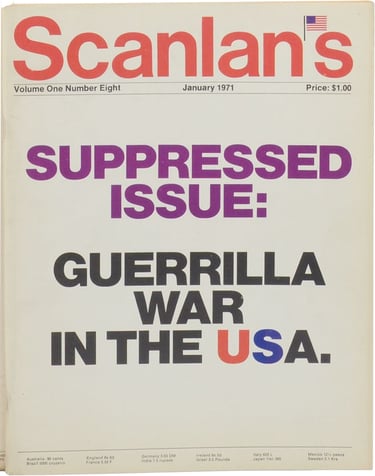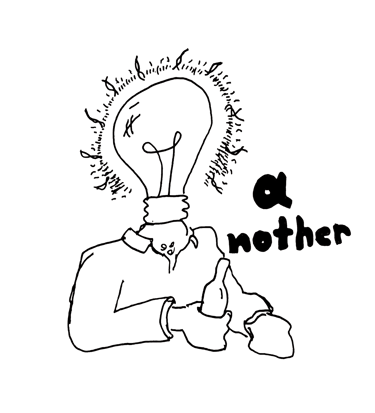

Scanlan's Monthly: the magazine that was despised by Nixon, investigated by the FBI and seized by Montreal police
ARTICLE
Roland Miller
8/15/20254 min read
if you recognize this paper, you may be long in tooth!
________________________
If you recognize the cover of this issue of Running Man Press you may be over the hill and far away. The layout is heavily influenced by the second issue of the provocative and audacious magazine Scanlan’s Monthly, which was in print for just eight issues, spanning from March 1970 to January 1971. According to its founders, the monthly was named after an Irish pig farmer who was “the worst man who lived in Ireland.”
Scanlan’s was founded by Warren Hinkle and Sidney Zion and is famous for printing what is widely regarded as the first instance of Gonzo journalism–the Hunter S. Thompson article “The Kentucky Derby is Decadent and Depraved.” Thompson was featured in several issues including the first one, which included his notable article “The Last Temptation of Jean-Claude Killy” which was vehemently rejected by Playboy.
Warren Hinckle hailed from San Francisco and had previously edited a similar magazine from 1964-1969 called Ramparts, which, according to Time, Hinckle transformed “from a mediocre Catholic literary quarterly into a rampaging crusader for leftist causes.” The magazine was closely associated with the New Left and Hinckle himself called it “joyfully biased.”
Ramparts was skillfully designed and took a strong stance on political issues including one against the Vietnam War. The magazine–which became a monthly under Hinckle’s leadership–pumped out numerous anti-war articles and a photo essay by William F. Pepper in 1967 that depicted disturbing photos of Vietnamese children who had been injured by American attacks. This essay caught the attention of Martin Luther King Jr. and led him to publicly oppose the war. King even offered the sole rights of his speech to Ramparts.
After mismanagement of the budget and a decline in subscriptions and newsstand sales–topping out at 250,000–Ramparts filed for bankruptcy. Contributing editor Ralph J. Gleason and staffer Jann Wenner went on to found Rolling Stone. Hinckle went on to meet New York Times journalist and former lawyer Sydney Zion. The two got on like a house on fire and they both had a strong affinity for boozing around town–and the town was now New York.
Hinckle’s ability to successfully acquire funding was as impressive as his ability to part with it. He and Zion were so elated by their initial backing of $675,000 by Charles Plohn & Co. that they published the cheque on the cover of the first issue of Scanlan’s. A manifesto of sorts spanning the front and back cover proclaimed a higher level of editorial freedom than any other magazine due to their funding which had “no strings attached.” The last sentence states, “We will make no high-blown promises about how great this magazine is going to be. Pay the buck and turn the page.” That issue marked the beginning of a short-lived but eventful run.
Scanlan’s provocative nature was one that gained attention, both good and bad. Like Ramparts it was “respected and despised.” One fellow who was not especially fond of the monthly was Richard Nixon, who eventually demanded a lawsuit and an FBI investigation of the magazine. The cover of the fourth volume of Scanlan’s depicted a fist punching Nixon in the face with the title “Impeach Nixon.” This was in 1970, before things truly went south for the fellow.
Hinckle noted, “During the short-lived Scanlan’s carnival I became engaged in [a] ridiculous battle with Spiro Agnew over the alleged pirating of a suspect memorandum from his office; was censored in Ireland; upbraided by the Bank of America for instructing love children how to counterfeit its credit cards; sued for one million dollars by the Chief of Police of Los Angeles; threatened by Lufthansa Airlines for an innocent editorial prank which they claimed cost them dearly, and also some other things happened.”
Hinkle was responsible for bringing Thompson and Ralph Steadman together for the first time to report on the Kentucky Derby. This was the beginning of what would evolve into a fruitful and eventful relationship between the historic pairing. When speaking of Thompson to Running Man Press in September of 2024, Steadman said, “We got on from the first and Hunter always challenged and pushed me. I hope I did the same for him. I think we could be braver with the other at our side. We did not worry too much about upsetting someone; we were just after some kind of truth and that was very liberating.”
Thompson was happy to work for a monthly that was willing to give him the freedom to write in an unorthodox manner and pay him handsomely to do it. Thompson referred to Hinckle as “the best conceptual editor I ever worked with.”
The whole fiasco came to a head when Scanlan’s attempted to print issue number eight: Guerrilla War in the USA. According to the monthly, they were rejected by over fifty printers in the U.S. and had to look elsewhere. After months of delays the magazine–now with “Suppressed Issue” added to the title–was printed in Quebec, just outside of Montreal. Scanlan’s even changed its address to Saint-Jean-sur-Richelieu, QC. Many thousands of issues were then seized by Montreal police.
According to Hinckle: “We got into a huge printing squabble and had to print in Canada. . . . We later got word that this was the result of a call from the White House to the Canadian government saying, ‘Get these fuckers.’”
Shortly afterward Scanlan’s was forced to file for bankruptcy against Hinckle’s best efforts. The magazine has gone down as one that angered more people in a year’s time than any other. What it also managed to do was to create a breeding ground for new and creative forms of journalism–be it “joyfully biased” or not.
In Read All About It! Zion writes, “The point is we stayed true to our dream. We combined muckraking with literature and laughs—always there were laughs. Which is how Hinckle and I started. . . .
Though the laughs ran out for Hinckle and me, I drink to us every year on the anniversary of our death. To Scanlan’s, not to Warren, not to me, to Scanlan’s.”


RUNNING MAN PRESS
CoNTACT
info@runningmanpress.ca
© 2024. All rights reserved.
ads@runningmanpress.ca
